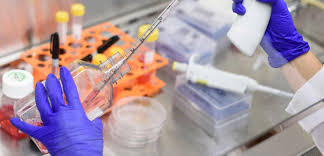Overview of Assessment:
This assessment is designed to link what you have learnt in theory classes to what we observe in the laboratory. It is a research assignment so it is expected that you will have to investigate some new information but then relate it back to the knowledge attained through this course. Please ensure that you complete the following essay questions whilst using the marking rubric to guide you.
BIOL2368 Microbiology Essay- RMIT University Australia.

Essay Question One – Share and Share Alike
In an old age centre a 84 year old man is in respiratory distress. Not only is he have trouble breathing but his breaths are short and unevenly paced. Two days ago, his wife, who shares a room with him in the old age centre, was hospitalised with a high fever. She suffered extreme pain every time she urinated. She also had stinging and itchiness around the groin area.
Pathology test results from the woman’s urine sample revealed:
after staining with lactophenol blue that these two types of microorganisms were present.

An antibiotic sensitivity plate was set up on from one of the microorganisms and revealed the following results.


Test results from the man’s sample revealed that he only had organism J in his lungs.
Both individuals were considered to be suffering from the same infection. The woman was thought to have the complication of a second infection. The woman is allergic to penicillin.
Based upon the places from where the specimens were collected, the symptoms in both patients and the pathology results
1.Guess what two microorganisms were present in the woman’s urine. What is the basis for your guess?
2.For each microorganism, label it as either normal flora, opportunistic pathogen, or pathogen. Provide an explanation of how you can to that decision
3.Explain why you believe that the woman’s allergy will or will not interfere with treating her infections.
4.Research the four most effective antibiotics. Outline the specific mechanisms they would use to break down the infective agent found in the man. Include information about their benefits and disadvantages.
5.Indicate which you would select for his treatment and why.
6.List two biochemical tests you could use
a. to distinguish microorganism J from different families of microorganisms.
b. List two biochemical tests you could use to differentiate microorganism J from different genera of microorganism within the same family. Be specific with what tests you include but also what results would appear for the other microorganism as well as for species J.
BIOL2368 Microbiology Essay- RMIT University Australia.

Essay Question Two –
This essay should include
1.Ways in which they differ from the other phyla of gram negative bacteria
2.A comparison of the different classes within proteobacteria including differences in their
a.Examples of each
b.Physical structures
c.Environments
d.Nutritional requirements
e.Methods of energy production
f.Pathologies they cause (might be to other plants, animals or microorganisms)
g.Features that scientists exploit to make new technologies
Essay Question Three – The Use of chemical agents to control microbial growth
The following picture shows a man close to death. He has been lost in the mountains for three weeks. He has been living off wild rabbits that he has minced up and made burgers from and he has been drinking water from the murky lake. One of his wounds arose on the first day when he became lost. A huge stone fell and crushed his leg. Over time the wound has become very dark and smelly. It is very swollen with gas. If it is not amputated soon, the man will die. An hour ago, in his weak and confused state, the man directly touched the hamburger grill and developed a severe (second degree) burn to his hand.Luckily for the man a search party with a paramedic and surgeon find him just in time. In their kit bags they have
A.Bandages and dressings, a thermometer, metal surgical tools, soap, a phenolic. alcohol, chlorine, iodine, silver nitrate, chlorhexidine, nitrites, a quaternary ammonium compound (QUAT),
BIOL2368 Microbiology Essay- RMIT University Australia.

1.Evaluate the picture above and indicate all potential risks from microorganism to the injured boy.
2.Looking closely at the diagram and the text description of it, identify how each type of chemical agent might be used in this scenario. Ensure that you include all the risks and benefits associated with each type of agent.

Scenario: This house has been left in a flooded state for 3 months. Once it was drained of water, the following growth was apparent on the wall. The owner has contracted microbiologists to determine if the sample is a fungus, algae or slime mould.
In the first part of you essay, you should perform research and address the likelihood that a fungus, algae or slime mould would start to grow on a damp wall in Melbourne. Provide your reasons for this point of view. List any species that you think this sample might represent.
Assuming that you can collect a sample and watch it go through its life cycle in the lab, provide images of how the life cycle would appear for a fungus, algae or slime mould. Be sure that you include a specific Genus name. Be sure that even if you are inspired by work found on the internet, that they cycle you provide is your own. Along with images, include a written description of each event in the cycles.
If the growth is painted over to improve the look of the wall, is the house safe to live in with the growth there? Justify your answer. Provide what measures you would take for one of the following two scenarios (that you believe to be the correct one).
(i) You believe the growth is safe but want to prevent future growth or
(ii) You believe the growth is unsafe and you wish to get rid of it.
Essay Question Five – Don’t fluke it – Win the Worm War
Worms (and flukes) affect billions of people, but they are barely spoken of in our society because there is a stigma attached to saying that you have had worms. Worm infections can vary from continent to continent. In your essay you represent a research team who is trying to appeal to the WHO (World Health Organisation) to raise funds to combat worm infections around the world.
Your essay must include
(i) The most common platyhelminths and nematodes (at least one fluke, one tapeworm and one roundworm). Talk about where they live, (in general terms) how they are transmitted and in detail, what pathology they cause.
(ii) Provide data for how many people worldwide are affected by each pathogen. Split that data into smaller groups if possible. Eg Australia or the developing world or travellers….
(iii) Provide a life cycle for one example that demonstrates how humans are the definitive host
(iv) Provide a life cycle for one example that demonstrates how humans are the intermediate host
(v) Research methods about how efforts are being made to control the vectors of some of these diseases in order to minimise pathology in humans



